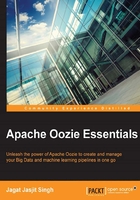
Conventions
In this book, you will find a number of text styles that distinguish between different kinds of information. Here are some examples of these styles and an explanation of their meaning.
Code words in text, database table names, folder names, filenames, file extensions, pathnames, dummy URLs, user input, and Twitter handles are shown as follows: "Now, edit the torrc file placed at the /etc/tor/ directory."
Most of the code in the book is XML. A block of code is set as follows:
<workflow-app name="My_first_Workflow" xmlns="uri:oozie:workflow:0.5">
<start to="fs-2178"/>
<kill name="Kill">
<message>Action failed </message>
</kill>
<action name="fs-2178">
<fs>
<delete path='${nameNode}/user/hue'/>
</fs>
<ok to="End"/>
<error to="Kill"/>
</action>
<end name="End"/>
</workflow-app>
Any command-line input or output is written as follows:
# $ hadoop fs -ls /user/hue/learn_oozie
New terms and important words are shown in bold. Words that you see on the screen, for example, in menus or dialog boxes, appear in the text like this: "Go to Settings | Networking | Port Forwarding , Click on Add new port forwarding."
Note
Warnings or important notes appear in a box like this.
Tip
Tips and tricks appear like this.